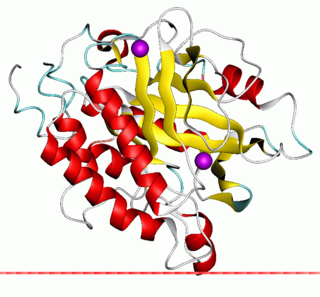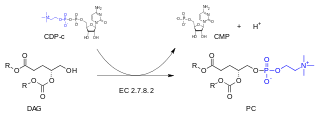| 1-acylglycerophosphocholine O-acyltransferase | |||||||||
|---|---|---|---|---|---|---|---|---|---|
| Identifiers | |||||||||
| EC no. | 2.3.1.23 | ||||||||
| CAS no. | 9027-64-9 | ||||||||
| Databases | |||||||||
| IntEnz | IntEnz view | ||||||||
| BRENDA | BRENDA entry | ||||||||
| ExPASy | NiceZyme view | ||||||||
| KEGG | KEGG entry | ||||||||
| MetaCyc | metabolic pathway | ||||||||
| PRIAM | profile | ||||||||
| PDB structures | RCSB PDB PDBe PDBsum | ||||||||
| Gene Ontology | AmiGO / QuickGO | ||||||||
| |||||||||
In enzymology, a 1-acylglycerophosphocholine O-acyltransferase (EC 2.3.1.23) is an enzyme that catalyzes the chemical reaction
- acyl-CoA + 1-acyl-sn-glycero-3-phosphocholine CoA + 1,2-diacyl-sn-glycero-3-phosphocholine
Thus, the two substrates of this enzyme are acyl-CoA and 1-acyl-sn-glycero-3-phosphocholine, whereas its two products are CoA and 1,2-diacyl-sn-glycero-3-phosphocholine.
This enzyme belongs to the family of transferases, specifically those acyltransferases transferring groups other than aminoacyl groups. The systematic name of this enzyme class is acyl-CoA:1-acyl-sn-glycero-3-phosphocholine O-acyltransferase. Other names in common use include lysolecithin acyltransferase, 1-acyl-sn-glycero-3-phosphocholine acyltransferase, acyl coenzyme A-monoacylphosphatidylcholine acyltransferase, acyl-CoA:1-acyl-glycero-3-phosphocholine transacylase, lysophosphatide acyltransferase, and lysophosphatidylcholine acyltransferase. This enzyme participates in glycerophospholipid metabolism.




